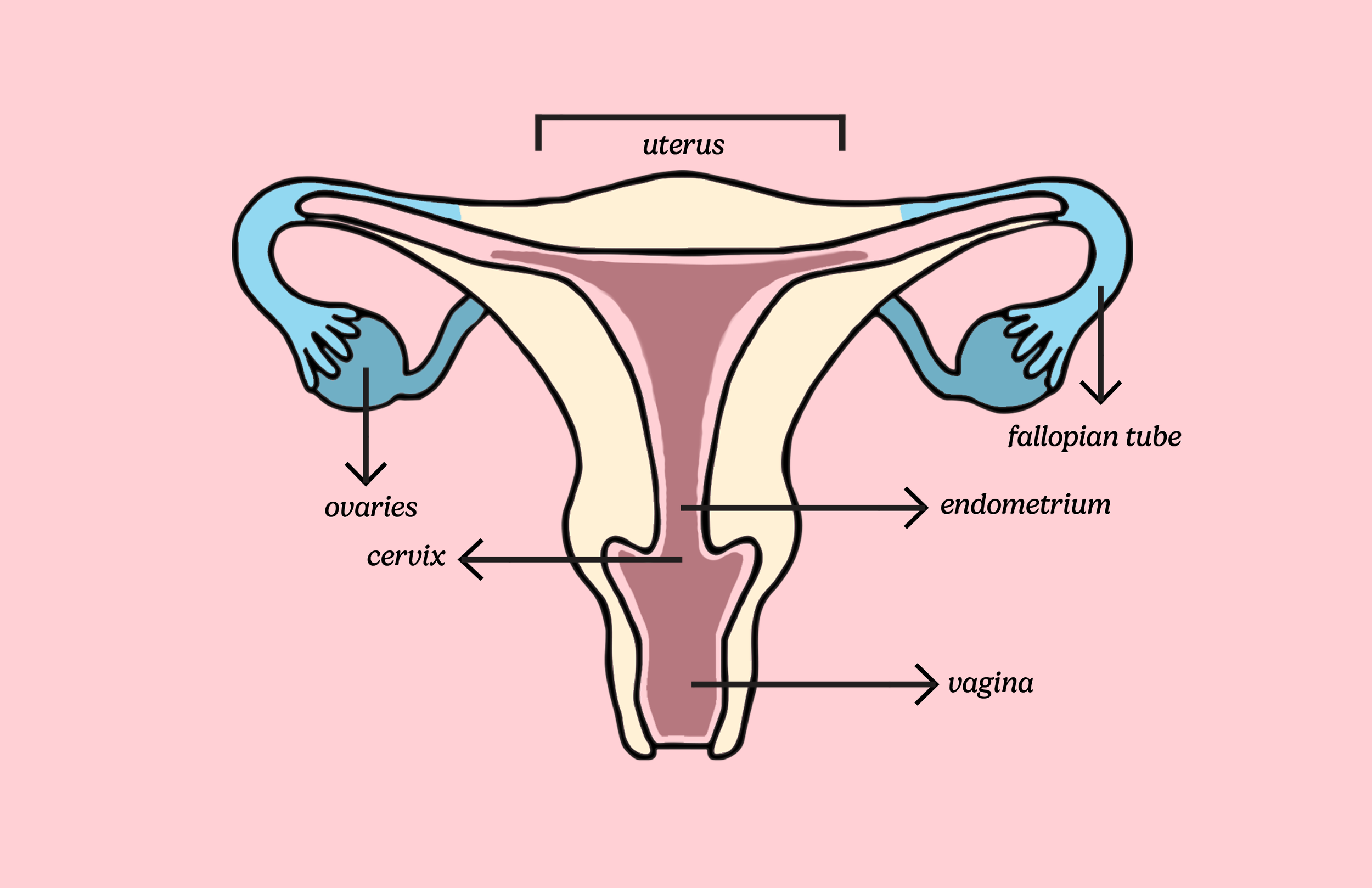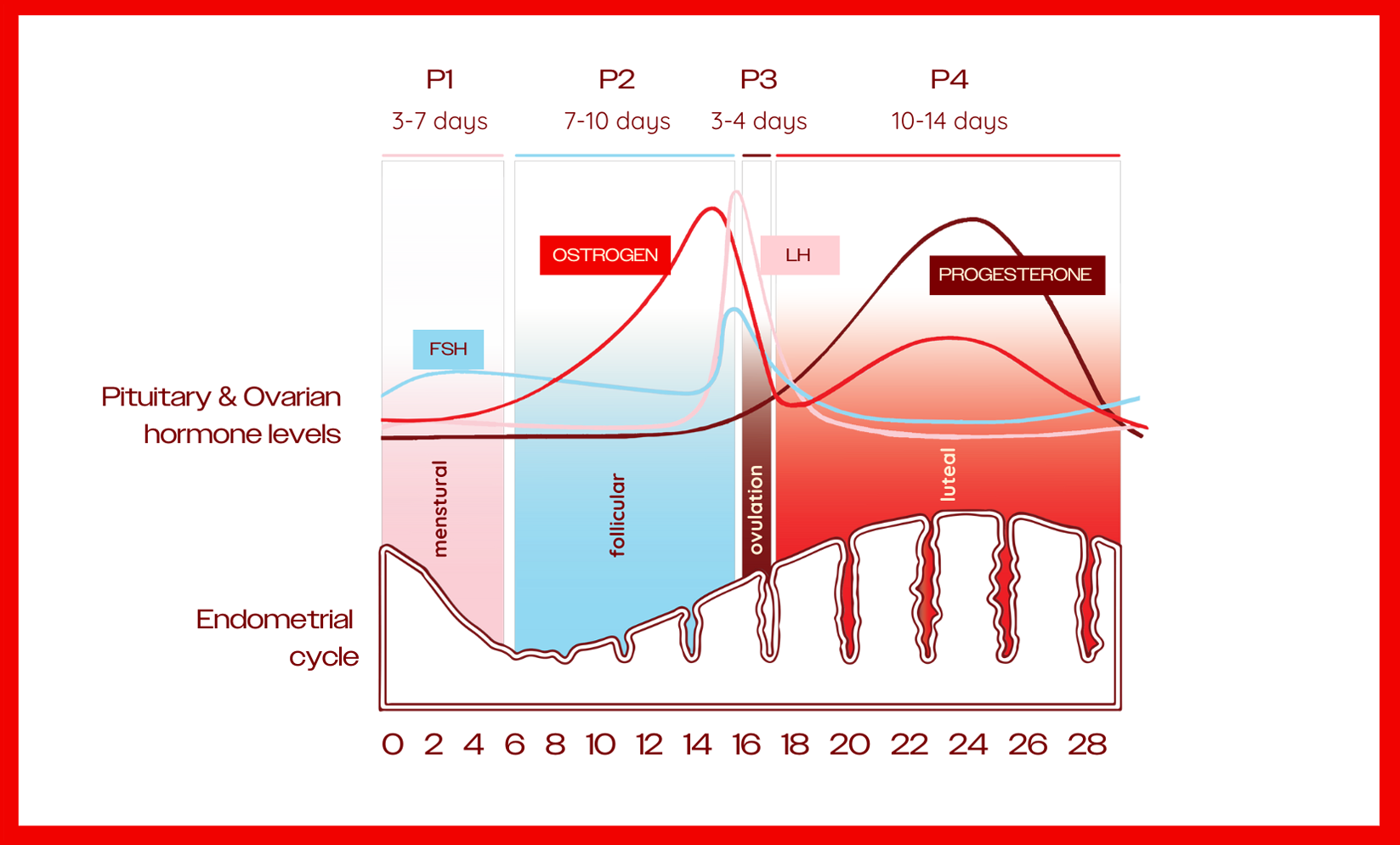learn to love your cycle
〰️
learn to love your cycle 〰️
Menstrual Cycle Basics
What even is a period?
And what do we mean when we say the word menstruation?
(yep, we’re going back down to the bloody basics!)
Menstruation is the monthly shedding of the lining of your uterus. Your uterus is where a foetus (unborn baby) develops and grows, and is also called a womb. (1)
Menstrual fluid — which is the blood and tissue from the inside of your uterus — flows from your uterus through your cervix and out of your body through your vagina.
If you don’t know where all of those body parts are – you’re not alone. Here’s a guide.
Our menstrual cycle is the hormonal and physical changes your body goes through between the first day of your period and the time before the next period.
Why do we menstruate?
Each month, our body prepares for pregnancy (evolution and all that). In preparation for nurturing a fertilised egg, the lining of your uterus gets thicker. During ovulation, an egg is released and is ready to be fertilised, to then settle in the lining of your uterus. If the egg is not fertilised, your body no longer needs the thicker lining, so it starts to break down and is eventually expelled, so you get your period (tada!). (2)
That means your periods are a sign that you’re not pregnant, along with being an indicator of your general health.
How long is the cycle?
You’ve probably heard cycles are typically 28 days and thought to yourself “hmmm… maybe something’s wrong with me?” Well you might be pleased to know that 87% of women don’t have a 28-day cycle. (3) Typically, menstrual cycles last between 24-38 days, so you have leeway! (4)
You’ll have around 450 periods in your life, from ages 8-15 until 44-50. (5)
Important note to take with you throughout this guide: every person is different – and so are our menstrual cycles. No two people will have the same menstrual cycle. That’s why this is a guide, not a rulebook. It’s also why tracking your menstrual cycle and understanding how it influences you can become your personal superpower.
Our Menstrual Phases
references (6, 7, 8)Our menstrual cycle can be broken down into two overarching phases, based around changes in the ovaries. These are known as the follicular and luteal phase, with two shorter phases within them. 2*2=4. Also known as the menstrual, follicular, ovulatory, and luteal phases! (9)
In each of these phases, our hormones change, and so do our bodies and feelings.
Ever felt super energised, but weren’t sure why? Or went for a run and didn’t manage to go as fast as last time, and still weren’t sure why? That might have been because of hormone changes.
The best metaphor for them are inner seasons. Think of the classic depictions of each season, and those might act as a good representation of how you and your body might feel in each of these phases.
🩸 keep reading to find out about those without periods & the menstrual cycle when on the pill 🩸
Very briefly, before we dive deeper later on:
Menstruation might feel a bit like winter, but that doesn’t mean it’s all doom and gloom. Think hibernation, carbohydrates and snuggling up with a hot chocolate.
Your follicular phase might feel like spring. Full of curiosity, imagination, possibility, and enthusiasm.
Around the time of ovulation it might feel like summer. Everyone’s favourite season. You’re on a high: confident, sociable and energised.
Your luteal phase is most like autumn. The summer leaves fall, multi-coloured on the ground. This is a time for focus, insight, and (unfortunately) your inner critic.
Learn about your cycle, in alignment with your cycle
What about those without periods?
What are their cycles?
Everyone has a circadian rhythm, which refers to the cycle of hormones that help us to wake up and feel awake in the morning, and sleepy at night, for the vast majority of humans. Women and people who menstruate also have this cycle, but we also have our menstrual cycle on top of our circadian rhythm. (10)
PS: some research suggests that people born male may also have a different hormonal cycle, but more research needs to be done
Postmenopausal women have reduced levels of oestrogen and progesterone, which means they no longer go through the phases of the menstrual cycle. (11)
Before your first period, you experience a steady increase in hormones, so you may start to notice some symptoms that are in keeping with the phases of your cycle. (12) Most girls and those with female reproductive organs will start their periods between age 12 and 13, but this is just an average: you may start earlier or later. (13) Usually periods start two to three years after breast development. (13)
And contraception?
How does that impact our cycle?
If you're on the standard combined oral contraceptive, the raised levels of progesterone and oestrogen abolish the normal hormonal cycling, and the typical menstrual cycle phases. While you may not have the typical cycle changes, you may still experience some menstrual symptoms, especially if you have a hormone-free interval. (14)
"Because of the intricate feedback loops controlling the menstrual cycle, artificially altering one or two hormones can affect the entire cycle. This fundamental knowledge has been used both to suppress the cycle, with the goal of contraception, as well as to stimulate ovulation with the hopes of promoting fertility.” (14)
go to next section
〰️
go to next section 〰️
delve deeper into the science behind our menstrual cycles - FREE section
-
1. NCI Dictionary of Cancer terms, Comprehensive Cancer Information - NCI. Available at: https://www.cancer.gov/publications/dictionaries/cancer-terms/def/uterus (Accessed: 02 May 2024).
2. Jain V, Chodankar RR, Maybin JA, Critchley HO. Uterine bleeding: how understanding endometrial physiology underpins menstrual health. Nature Reviews Endocrinology. 2022 May;18(5):290-308.
2. Soumpasis I, Grace B, Johnson S. Real-life insights on menstrual cycles and ovulation using big data. Hum Reprod Open. 2020 Apr 16;2020(2):hoaa011. doi: 10.1093/hropen/hoaa011. PMID: 32328534; PMCID: PMC7164578.
3. Fraser IS, Critchley HO, Broder M, Munro MG. The FIGO recommendations on terminologies and definitions for normal and abnormal uterine bleeding. Semin Reprod Med. 2011 Sep;29(5):383-90.
4. Chavez-MacGregor M, Van Gils CH, Van Der Schouw YT, Monninkhof E, Van Noord PA, Peeters PH. Lifetime cumulative number of menstrual cycles and serum sex hormone levels in postmenopausal women. Breast cancer research and treatment. 2008 Mar;108:101-12.
5. American College of Obstetricians & Gynecologists. 2020. Heavy and Abnormal Periods. https://www.acog.org/womens-health/faqs/heavy-and-abnormal-periods Date accessed: 25th August 2023.
6. Fehring RJ, Schneider M, Raviele K. Variability in the phases of the menstrual cycle. JOGNN. 2006;35: 376-384.
7. Lenton EA, Landgren BM, Sexton L. Normal variation in the length of the luteal phase of the menstrual cycle: identification of the short luteal phase. BJOG. 1984;91:685-9.
8. Reed BG, Carr BR. The Normal Menstrual Cycle and the Control of Ovulation. [Updated 2018 Aug 5]. In: Feingold KR, Anawalt B, Blackman MR, et al., editors. Endotext [Internet]. South Dartmouth (MA): MDText.com, Inc.; 2000-. Available from: https://www.ncbi.nlm.nih.gov/books/NBK279054/
9. Baker FC, Driver HS. Circadian rhythms, sleep, and the menstrual cycle. Sleep medicine. 2007 Sep 1;8(6):613-22.
10. Saxena K, Madan A. Menopause: How Women’s Health is Affected? Acta Scientific Women's Health. 2023 Feb;5(2):e ISSN: 2582-3205.
11. Breehl L, Caban O. Physiology, puberty.
12. American College of Obstetricians & Gynecologists. 2022. Your First Period. https://www.acog.org/womens-health/faqs/your-first-period Date accessed: 25th August 2023.
13. De Leo V, Musacchio MC, Cappelli V, Piomboni P, Morgante G. Hormonal contraceptives: pharmacology tailored to women's health. Hum Reprod Update. 2016 Sep;22(5):634-46. doi: 10.1093/humupd/dmw016. Epub 2016 Jun 15. PMID: 27307386.
14. Nottke A. 2008. Taming the cycle: how does the pill work. Harvard University: Science in the news. .https://sitn.hms.harvard.edu/flash/2008/issue40/ Date accessed: 26th August 2023.



